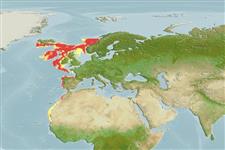Common names from other countries
Пластиножаберные (акулы и скаты) (sharks and rays) >
Rajiformes (Skates and rays) >
Rajidae (Skates)
Etymology: Dipturus: Greek, di = two + Greek, pteryx = fin (Ref. 45335).
Environment: milieu / climate zone / depth range / distribution range
экология
морской батидемерсальный; пределы глубины 125 - 1420 m (Ref. 114953). Deep-water; 67°N - 16°N, 25°W - 14°E
Eastern Atlantic: fjords of central and southern Norway, southern Iceland, around Rockall Trough in Ireland and northern Mauritania (Ref. 4426); Western and central Mediterreneann Sea (Ref. 125963).
Size / Вес / Возраст
Maturity: Lm ? range ? - ? cm
Max length : 200 cm TL самец/пол неопределен; (Ref. 4426)
Inhabit deep slope waters (Ref. 3167), probably most common on the mid-slope (Ref. 114953). Feed on all kinds of bottom animals (Ref. 3167), mainly invertebrates and small fishes (Ref. 114953). Size possibly up to 250 cm TL (Ref. 114953). Oviparous. Distinct pairing with embrace. Young may tend to follow large objects, such as their mother (Ref. 205). Eggs are oblong capsules with stiff pointed horns at the corners deposited in sandy or muddy flats (Ref. 205). Egg capsules are 18.2-26.0 cm long and 9.2-11.3 cm wide (Ref. 41251, 41309). Sizes of maturity and hatching unknown (Ref. 114953).
Life cycle and mating behavior
Maturities | размножение | Spawnings | Egg(s) | Fecundities | личинки
Oviparous, paired eggs are laid. Embryos feed solely on yolk (Ref. 50449). Distinct pairing with embrace. Young may tend to follow large objects, such as their mother (Ref. 205).
McEachran, J.D. and K.A. Dunn, 1998. Phylogenetic analysis of skates, a morphologically conservative clade of elasmobranchs (Chondrichthyes: Rajidae). Copeia 1998(2):271-290. (Ref. 27314)
Статус Красного Списка МСОП (Ref. 130435)
CITES (Ref. 128078)
Not Evaluated
Угроза для людей
Harmless
Использование человеком
рыболовство: интереса не представляет
дополнительная информация
инструменты
Специальные отчеты
Скачать в формате XML
ресурсы в Интернет
Estimates based on models
Preferred temperature (Ref.
115969): 2.1 - 10.8, mean 7.1 (based on 138 cells).
Phylogenetic diversity index (Ref.
82804): PD
50 = 0.5000 [Uniqueness, from 0.5 = low to 2.0 = high].
Bayesian length-weight: a=0.00282 (0.00133 - 0.00596), b=3.25 (3.08 - 3.42), in cm Total Length, based on LWR estimates for this Genus-body shape (Ref.
93245).
Trophic level (Ref.
69278): 3.5 ±0.37 se; based on food items.
устойчивость к внешним воздействиям (Ref.
120179): низкий, минимальное время удвоения популяции 4.5-14 лет (Fec assumed to be <100).
Fishing Vulnerability (Ref.
59153): Very high vulnerability (90 of 100).
